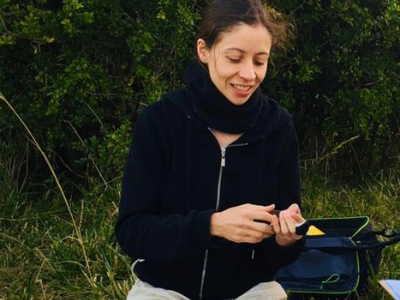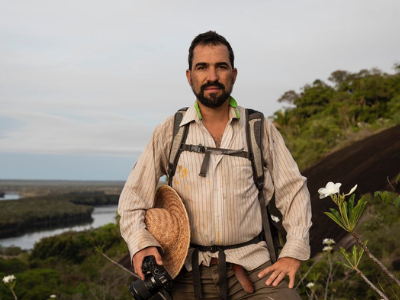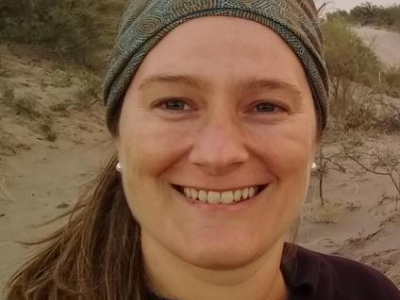The American Ornithological Society (AOS) Conservation Committee recognizes the urgent need to conduct timely research on the many declining bird species across the Americas and support researchers from countries where funding for scientific endeavors is less available. In 2023, the committee initiated a new Latin America and Caribbean Conservation Research Awards (LACCRA) small grants initiative, focused on early-career ornithologists based in or from Latin America or the Caribbean to support conservation-related research on migratory or resident birds in these regions.
“The Conservation Committee of the AOS is incredibly pleased to see the new LACCRA grants program underway, and to help support scientists in Latin America and the Caribbean conducting timely research geared towards the improved understanding of declining birds in the Americas,” says committee co-chair Anna Chalfoun.
We are thrilled to announce the winners of the 2023 inaugural AOS Latin America and Caribbean Conservation Research Awards. Drs. Valentina Gómez-Bahamón and Sergio Estrada Villegas won for their project, “The importance of small forest islands in tropical savannas of South America for bird life history;” and Dr. María Emilia Rebollo won for her project, “Association between bird diversity, habitat features and a forest intervention with abundance of the endangered Yellow Cardinal (Gubernatrix cristata).”
“All three award recipients have proposed exciting research well aligned with the intent of our new grants program,” AOS president Colleen Handel says. “Their studies should all have tangible and immediate impacts, each addressing in different ways how the conservation and management of key habitats can affect the diversity and conservation of birds in their regions.”

Valentina Gómez-Bahamón
Eberly Postdoctoral Fellow in the Toews Lab at The Pennsylvania State University
Dr. Valentina Gómez-Bahamón’s research aims to understand the role of behavior in the origination of species and their probability of persisting under current environmental challenges. Dr. Gómez-Bahamón conducted her doctoral training at the Field Museum in Chicago and the University of Illinois–Chicago. She has been a member of the AOS since 2017, when she was a recipient of an AOS graduate student research award to conduct research on non-vocal acoustic signals of Fork-tailed Flycatchers (Tyrannus savana). She has also been an active member of the non-profit organization SELVA: Research for Conservation in the Neotropics in Colombia since 2011.

Sergio Estrada Villegas
Junior Assistant Professor at the Universidad del Rosario, Bogotá, Colombia
Dr. Sergio Estrada Villegas is a junior assistant professor at Universidad del Rosario in Bogotá, Colombia. He has more than 15 years of experience in research, ecosystem conservation, and stakeholder involvement across Latin America, including in his home country of Colombia. During his career, Dr. Estrada Villegas started a local NGO, established an experimental field station, and worked side by side with passionate researchers and conservationists from local, regional, and international institutions. His research, pedagogical activities, and conservation initiatives are geared to the protection of tropical ecosystems currently facing rapid and dramatic land use change, including savannas.
Joint project title: “The importance of small forest islands in tropical savannas of South America for bird life history”
Abstract: Tropical grasslands of South America are being rapidly transformed into extensive monocultures of exotic timber species and crops. These grasslands include small forest islands that provide important resources for many bird species. However, these forest patches are the first to disappear with habitat transformation, and little work has been done to document the impact of their loss on biodiversity. Our observations in Colombia suggest that these small forest islands provide important resources for different aspects of a bird’s life history. Many species of tyrant flycatchers, tanagers, icterids, jacamars, and sparrows, among others, use these islands for nesting, roosting, displaying, foraging, copulating, and escaping from predators. Moreover, our observations indicate that riparian forest specialists occasionally use them for dispersing. Our goal is to quantitatively document these observations and determine which features of these small islands are most important for local and migratory birds in the Colombian Llanos. Moreover, we will compare bird behavior and species composition between small forest islands, a protected nature reserve and a plantation of an exotic timber species (Acacia mangium). Our results will show the impact of the transformation of tropical savannas on bird behavior and composition, highlighting the importance of small forest islands.

Dr. María Emilia Rebollo
Postdoctoral Fellow at CONICET, Argentina; ColBEC (FCEyN, UNLPam); INCITAP (CONICET, UNLPam)
Dr. María Emilia Rebollo is a biologist and postdoctoral fellow of CONICET working on the endangered Yellow Cardinal conservation in central Argentina. Her career as ornithologist started as volunteer field assistant in 2010, when she collaborated on a research project with her university, Universidad Nacional de La Pampa (UNLPam). In 2015, she completed her undergraduate research project on the breeding biology of the Tufted Tit-Spinetail. In 2020, she completed her doctoral dissertation on the breeding ecology of two neotropical austral migrant flycatchers. Dr. Rebollo was also a recipient of a 2020 AOS Student Membership Award.
Project title: “Association between bird diversity, habitat features and a forest intervention with abundance of the endangered Yellow Cardinal (Gubernatrix cristata)”
Abstract: The biodiversity loss is one of the most worrying environmental issues that exist on our planet. Habitat loss and degradation is one of its main drivers. The Yellow Cardinal (Gubernatrix cristata) is a globally endangered bird that inhabits South America and whose main threats are habitat loss/degradation and illegal trapping. Our general objective is to analyze the relationship of different factors with the abundance of Yellow Cardinals in the Caldén (Prosopis caldenia) forest of La Pampa province, Argentina. We will evaluate how Yellow Cardinal abundance is related to 1) bird diversity: species richness, evenness, abundance, and rarity; 2) habitat features: distance to roads, towns/cities, and water reservoirs, cattle production presence, sport hunting presence, and vegetable coverage at grass, shrubs/sapling and trees stratus; and 3) a forest management intervention (mechanical thinning). Bird census using occupancy techniques in 100 point counts across the forest of La Pampa and 30 simple point counts in a ranch with the intervention will be carried out. This project will help to provide scientific evidence on how bird diversity, land use (cattle production, sport hunting and urbanization) is linked with Yellow Cardinal abundance. This information could be used to make decisions and to promote biodiversity conservation actions.